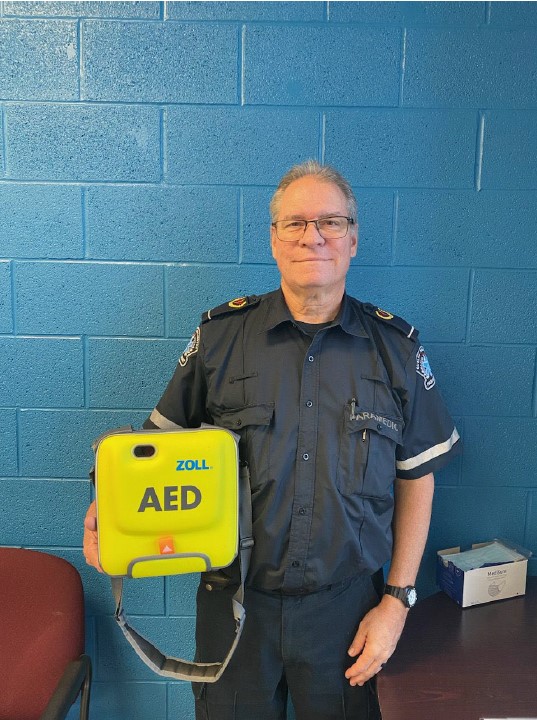On this page
An automated external defibrillator (AED) is a portable device that analyzes a victim’s heart rhythm and, if necessary, allows a rescuer to deliver an electrical shock to the victim of sudden cardiac arrest.
This allows immediate intervention in a cardiac arrest situation when medical assistance may be several critical minutes away.
Public access defibrillators are available for use by anyone although training in the use of an Automated External Defibrillator is recommended. Ambulance dispatchers can talk bystanders through the use of an automated external defibrillator in an emergency situation until paramedics arrive.
Guelph Wellington Paramedic Service Public Access Defibrillation program

Guelph Wellington Paramedic Service can register your facilities public access defibrillator (PAD) with the 911 ambulance dispatch agency. This can ensure that a caller to 911 ambulance dispatch has the information required to make a difference.
Use the web form if there are one to five defibrillators at your location. If there are more than five, use the Excel version below.
AED Public Registration Template for more than five defibrillators (Excel)
The Paramedic service will connect with you and ensure the device is in working order and validate the location for appropriate registry. In order to maintain the registration with the 911 agency, the paramedic service will review your device and information annually.

The Guelph Wellington Paramedic Service Public Access Defibrillation program now has more than 500 Automated External Defibrillators throughout Guelph and Wellington County. Automated external defibrillators can be found at public venues, community centres, hockey arenas, and in most schools.
Facts about cardiac arrest and defibrillation
- Cardiac refers to the heart. Arrest means stop. Sudden cardiac arrest is the sudden and unexpected loss of heart function in a person.
- Signs of cardiac arrest include: no breathing or intermittent gasping for air, no movement or response to initial rescue breaths, or poor colour or no pulse.
- In Canada, 35,000 to 45,000 people die of sudden cardiac arrest each year.
- For every one-minute delay in defibrillation, the survival rate of a cardiac arrest victim decreases by 7 to 10%. After more than 12 minutes of ventricular fibrillation, the survival rate of adults is less than 5%.
Early access to 911 is the first link in the patient’s chain of survival.

The Ontario Heart and Stroke’s Chain of Survival depicts the critical actions required to treat life-threatening emergencies, including heart attack, cardiac arrest, stroke, and foreign body airway obstruction. The links within this “Chain of Survival” include:
- Early access to the emergency response system.
- Early CPR to support circulation to the heart and brain until normal heart activity is restored.
- Early Defibrillation to treat cardiac arrest caused by Ventricular Fibrillation; and
- Early Advanced Care by EMS and hospital personnel.
The first link, Early Access to the emergency response system, includes early recognition of the cardiac emergency and early notification of rescue personnel via a universal 9-1-1-telephone system as well as an internal alert system within specific facilities to trigger a response by designated trained and equipped personnel.
The second link, early CPR, is a set of actions that the rescuer performs in sequence to assess and support airway, breathing and circulation.
The third link, early Defibrillation, is the delivery of a shock to the heart to convert the heart’s rhythm from Ventricular Fibrillation back to a normal heart rhythm.
References
- Gardiner, Martin J., Leather, Richard and Teo, Koon, The Prevention of Sudden Death from Ventricular Arrhythmia, Chapter 1, Epidemiology, Canadian Cardiovascular Society, 1999.
- Larsen MO, Eisenberg MS, Cummins RO, et al. Predicting survival from out-of hospital cardiac arrest: a graphic model. Annals of Emergency Medicine 1993;22:1642-1658
- ZOLL Medical Website
We can also assist with the grant process for obtaining a PAD and can assist with oversight and best practices information.
For more information
Office: 519-822-1260 extension 3379
Email: [email protected]
